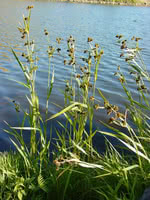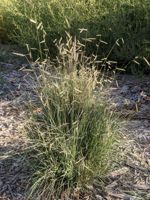Mon-Fri 9am - 5pm Mountain time
Green Bulrush vs Blue Grama Grass
Scirpus pallidus
Bouteloua gracilis
CUSTOM GROW
NOT AVAILABLE THIS SEASON - MIGHT RETURN
Green Bulrush is a common waterside plant, suitable for erosion control and land reclamation. Despite this, Green Bulrush is very drought resistant once established. Bulrushes can cool nearby areas on hot days.
Unlike many of the other waterside plants available, Green Bulrush does not attract wildlife. This makes it a good choice for surrounding residential water sources.
Green Bulrush is topped with spiky balls of florets, green in the spring and fading to brown in the fall.
Blue Grama is a native perennial bunchgrass recognized for its blue-green blades and unique seed heads. They grow along one side of the stem and are often compared to eyelashes, eyebrows, or mosquito larvae, which inspired its common names, Eyelash Grass and Mosquito Grass. As the seed heads begin to dry in the fall, they curl, further enhancing the plant’s distinctive appearance. The seeds provide food for birds, and the grass serves as a host plant for certain species of skipper butterflies.
As a warm-season grass, Blue Grama has a slow start in spring and does not actively grow until soil temperatures rise. Its deep roots help with erosion control, and the grass is drought-tolerant once established, thriving even in poor or alkaline soils. It is well-suited for soil stabilization, naturalization, restoration projects, or as an ornamental accent in gardens and landscapes.

